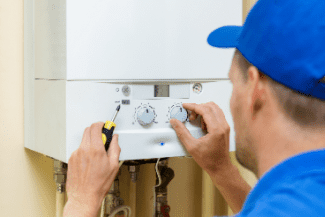All the Pros and Cons You Need to Know About Tankless Water Heaters
Make the switch to a tankless system to get on-demand hot water.

Tankless water heaters take up a lot less space than a traditional tank-style heater, and they are typically more efficient. These systems heat water on demand instead of continually maintaining the heat level of an entire tank of water. On-demand hot water is achieved by running a cold water line into the tankless water heater so that the water flows through the heating element. During the brief period when the water is inside the heater, the element rapidly heats the water. The heated water then exits the water heater and flows to the open faucet.
Due to this method of heating the water, tankless water heaters do not need to be active constantly. Additionally, there is no limit to the amount of hot water, so users don’t need to worry about running out midway through a shower. Find out more about tankless water heater pros and cons to help you decide if a tankless system is right for your home.
Tankless Water Heater Installation
An important factor to consider when looking into purchasing a tankless water heater is the installation process. It isn’t recommended for a DIYer to attempt to replace a water heater due to the complexity of the project and the professional know-how that is necessary to ensure a water heater is working properly.
Most plumbing companies are able to remove an old tank-style water heater and install a new tankless water heater, though the cost of this service varies depending on the size, type, and fuel the water heater uses. For instance, while a non-condensing tankless water heater unit is more affordable than a condensing unit, you might end up paying more in labor to have a non-condensing water heater installed because they require a stainless-steel exhaust system to function properly.
If you don’t have a go-to plumbing company, take some time to research local options and compare the pricing, installation process, and warranties of each before deciding on the right company to complete the work.
Types of Tankless Water Heaters
There are several types of tankless water heaters that can be differentiated based on the way in which they heat water, the fuel that is used, and whether the unit is designed for whole-home or point-of-use heating.
Gas Tankless Water Heaters: These burn propane or natural gas to heat the water as it flows through the system. This category of heater can be split into two groups, including non-condensing and condensing.
Non-Condensing Tankless Water Heaters: This type of water heater burns propane or natural gas, then uses a primary heat exchanger that rapidly heats the water as it flows through the heater. This process creates hot exhaust, which must be vented through stainless-steel flue pipes. While non-condensing tankless water heaters are more affordable, the stainless-steel exhaust system can increase the overall cost of the installation.
Condensing Tankless Water Heaters: This is a more efficient type of gas water heater. It has a secondary heat exchanger that uses the heat from the exhaust to begin warming the water before it reaches the primary heat exchanger. This process increases the efficiency of the tankless water heater, and it cools the exhaust gas, so you don’t need to pay for an expensive stainless-steel exhaust system.
Electric Tankless Water Heaters: These don’t rely on a heat exchanger. Instead, the water rapidly heats when it flows directly through the electric heating element inside the tankless water heater. These systems are typically less expensive to install than a gas tankless water heater but more expensive to operate.
Point-of-Use Tankless Water Heaters: This is a smaller alternative to whole-home tankless water heaters. As the name suggests, instead of heating the water for the entire home, point-of-use water heaters are set up in close proximity to a single faucet, shower, or appliance to rapidly heat the water at the point of use.
Tankless Water Heater Benefits
A tankless water heating system is a relatively new product developed with several key changes to improve the way in which you heat water in your home.
On-Demand Heating: Allows the user to turn on any hot water faucet and get hot water almost instantaneously. Tank-style water heaters take more time to heat the water stored in the tank.
High-Efficiency and Energy-Saving Designs: Tankless water heaters help reduce overall energy costs and keep more money in your pocket. A tankless water heater only activates when hot water is needed, instead of continuously using energy to heat and reheat a standing tank of water, even when hot water isn’t being used.
Space-Saving Sizes: Smaller homes can get on-demand access to hot water without having to dedicate a large area to a bulky water tank.
Limitless Hot Water: Users don’t need to worry about the shower suddenly getting cold, which happens when a tank-style water heater runs out of hot water.
Long-Lasting Durability: Tankless water heaters last for up to 20 years before needing to be replaced. For comparison, tank-style water heaters have an average life of about 12 years.
Tankless Water Heater Drawbacks
While there are several key benefits of tankless water heaters, there are also a number of limitations that might cause you to reconsider whether a tankless water heater is the right choice for your home.
High Purchase and Installation Costs: The price of a tankless water heater can be a restrictive factor. Installing a tank-style water heater typically costs about $900, while the average cost to install a tankless water heater can exceed $3,000.
Limited Flow Rates: Reduced flow rates can lead to poor heating efficiency and low-temperature water. Before deciding on a tankless water heater, make sure to speak to an experienced plumber about the appropriate flow rate for your home. Keep in mind that, in most cases, the higher the flow rate, the more costly the water heater.
Multiple Units for Larger Properties: Generally, larger homes and larger families will have a higher demand for hot water. To keep up with this demand, you may need to install more than one tankless water heater or invest in a high-end tankless water heater with a very high flow rate. This ensures water is heated to an optimal temperature.
Price of Tankless Water Heaters
One of the main drawbacks that prevent people from making the switch to a tankless water heater system is that they cost about three times as much to purchase and install as a tank-style water heater. According to HomeGuide, the average cost to install a tankless water heater ranges from about $800 to $3,500.
The price of these systems can increase or decrease depending on the size, flow rate, fuel, and type, so it’s important to discuss your options with a professional plumber before deciding on the best tankless water heater for your home. For instance, an electric tankless water heater has a lower initial cost than a gas tankless water heater. Similarly, a non-condensing gas tankless water heater costs less than a condensing gas tankless water heater, though you may pay a higher installation price to put in stainless-steel flue pipes to vent the exhaust from a non-condensing system.
However, when considering the high price of a tankless water heater, it’s also necessary to keep in mind that these systems are more efficient than a traditional tank-style water heater, so you will also reduce your yearly energy costs and save money in the long run.
Source: Better Homes & Gardens















 Accessibility
Accessibility